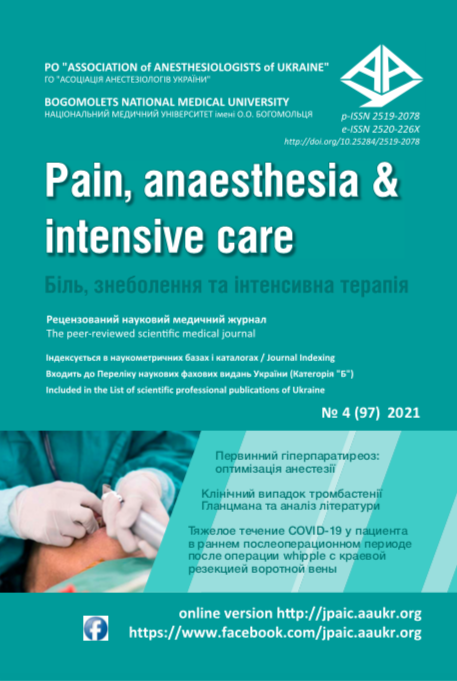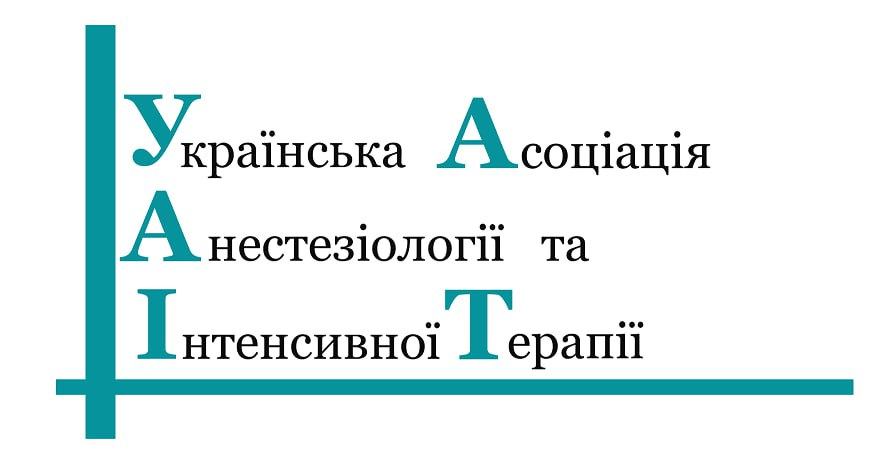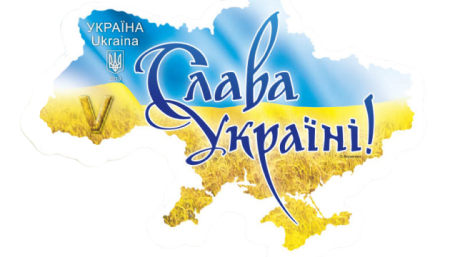ОСОБЛИВОСТІ СЕРЦЕВО-ЛЕГЕНЕВОЇ РЕАНІМАЦІЇ У ХВОРИХ З МОРБІДНИМ ОЖИРІННЯМ
DOI:
https://doi.org/10.25284/2519-2078.4(97).2021.248391Ключові слова:
Морбідне ожиріння, серцево-легенева реанімація, раптова смертьАнотація
Резюме. Серцево-легенева реанімація пацієнта з ожирінням може представляти проблему навіть для найдосвідченішого лікаря. Зміни в анатомії, метаболізмі, серцево-легеневому резерві, вентиляції, кровообігу та фармакокінетиці ліків потребують особливого розгляду. Ця стаття присвячена найважливішим компонентам реанімації пацієнта з ожирінням, а саме особливостям проведення непрямого масажу серця, дефібриляції, забезпечення прохідності верхніх дихальних шляхів та вентиляції, фармакокінетики вазоактивних речовин.
Матеріали та методи. Пошук в електронних базах даних Scopus та PubMed здійснювався за допомогою ключових слів.
Результати та висновки. Ожиріння викликає важливі анатомічні та фізіологічні зміни, які впливають на реанімаційні заходи. Медичним працівникам слід враховувати особливості проведення серцево-легеневої реанімації у хворих з морбідним ожирінням для підвищення ефективності реанімаційних заходів у даної групи пацієнтів.
Посилання
Devallence E, Fournier SB, Donley DA, Bonner DE, Lee K, Frisbee JC, Chantler PD. Is obesity predictive of cardiovascular dysfunction independent of cardiovascular risk factors? Int J Obes. 2015;39(2):244–253. doi: 10.1038/ijo.2014.111
 |
| 
Noheria A, Teodorescu C, Uy-Evanado A, Reinier K, Mariani R, Gunson K, Jui J, Chugh SS. Distinctive profi le of sudden cardiac arrest in middle-aged vs. older adults: a community-based study. Int J Cardiol. 2013.168(4):3495–3499. doi: 10.1016/j.ijcard.2013.04.207.
 |
| 
Chen H., Deng Y. Relation of body mass index categories with risk of sudden cardiac death. A systematic review and meta-analysis.Int. Heart J. 2019. 60 (3): 624‒630. doi: 10.1536/ihj.18-155.
 |
| 
Kumar T., Jha K., Sharan A., Pooja Sakshi, Shishir Kumar, Amita Kumari. A Study of the effect of obesity on QT-interval among adults.J. Family Med. Prim. Care.2019.8(5):1626‒1629. doi: 10.4103/jfmpc.jfmpc_168_19.

Babatunde O Ogunnaike, Charles W Whitten, Abu Minhajuddin, Emily Melikman, Girish P Joshi, Tiffany S Moon, Preston M Schneider, Steven M Bradley, American Heart Association’s Get With The Guidelines(®)-Resuscitation Investigators. Body mass index and outcomes of in-hospital ventricular tachycardia and ventricular fi brillation arrest. Resuscitation. 2016. 105:156-60. doi:10.1016/j.resuscitation.2016.05.028.
 |
| 
Carsten Lott, Anatolij Truhlář, Annette Alfonzo, Alessandro Barelli, Violeta González-Salvado et al., ERC Special Circumstances Writing Group Collaborators. European Resuscitation Council Guidelines 2021: Cardiac arrest in special circumstances. (2021). Resuscitation. 2021.161:152-219. doi: 10.1016/j.resuscitation.2021.02.011.
 |
| 
Edelson DP, Abella BS, Kim S, Vanden Hoek TL, Becker LB. Abstract 56: The effects of obesity on CPR quality and survival after cardiac arrest. Circulation. 2006;114(Suppl 18):II-1199
Secombe P, Sutherland R, Johnson R. Body mass index and thoracic subcutaneous adipose tissue depth: possible implications for adequacy of chest compressions. BMC Res Notes. 2017;10:575. doi: 10.1186/s13104-017-2918-9
 |
| 
Wang C.H., Huang C.H., Chang W.T., Fu C.M., Wang H.C., Tsai M.S. et al. Associations between body size and outcomes of adult in hospital cardiac arrest: a retrospective cohort study. Resuscitation. 2018;130:67–72. doi: 10.1016/j.resuscitation.2018.07.006
 |
| 
Alkhoudi N., Mansfi eld J. The mechanical properties of human adipose tissues and their relationships to the structure of composition of the extracellular matrix. Am. J. Physiol. Endocrinol. Metab. 2013. 305 (12): E1427-Е1435. doi: 10.1152/ajpendo.00111.2013
 |
| 
Heekyung Lee, Jaehoon Oh, Juncheol Lee, Hyunggoo Kang, Tae Ho Lim, Byuk Sung Ko et al. Retrospective Study Using Computed Tomography to Compare Suffi cient Chest Compression Depth for Cardiopulmonary Resuscitation in Obese Patients. (2019). J Am Heart Assoc. 2019. 3; 8(23): e013948. Published online 2019 Nov 26. doi:10.1161/JAHA.119.013948
 |
| 
Lipman S., Cohen S., Einav S. et al. The society for obstetric anesthesia and perinatology consensus statement on the management of cardiac arrest in pregnancy. Anest. Analg.2014.118 (5):1003‒1016. DOI:10.1213/ANE.0000000000000171
 |
| 
Isono S. Obesity and obstructive sleep apnoea: Mechanisms for increased collapsibility of the passive pharyngeal airway. Respirology 2012;17(1):32–42. https://doi.org/10.1111/j.1440-1843.2011.02093.x
 |
| 
Wang T, Sun S, Huang S. The association of body mass index with diffi cult tracheal intubation management by direct laryngoscopy: A meta-analysis. BMC Anesthesiol 2018;18(1):1–13. doi: 10.1186/s12871-018-0534-4
 |
| 
Moon TS, Fox PE, Somasundaram A, et al. The influence of morbid obesity on diffi cult intubation and diffi cult mask ventilation. J Anesth 2019;33(1):96–102. doi: 10.1007/s00540-018-2592-7
 |
| 
Benger J.R., Kirby K., Black S. et al. Effect of a supraglottic airway device vs tracheal intubation during out-of-hospital cardiac arrest on functional outcome. JAMA, 2018, no. 320 (8), pp. 779‒791. doi: 10.1001/jama.2018.11597.
 |
| 
Shahreyar M., Dang G., Waqas B.M. et al. Outcomes of in-hospital cardiopulmonary resuscitation in morbidly obese patients. JACC Clin. Electrophysiol., 2017, vol. 3, no. 2, pp. 174‒183. doi: 10.1016/j.jacep.2016.08.011.
 |
| 
Zelinka M., Buić D., Zelinka I. Comparison of fi ve different defi brillators using recommended energy protocols. Resuscitation. 2007.74 (3): 500‒507. doi: 10.1016/j.resuscitation.2007.01.021
 |
| 
Ogunnaike B.O., Whitten C.W., Minhajuddin A. et al. Body mass index and outcomes of in-hospital ventricular tachycardia and ventricular fi brillation arrest. Resuscitation, 2016. 105: 156‒160. doi: 10.1016/j.resuscitation.2016.05.028
 |
| 
Sara Manning. The Crashing Obese Patient.Emerg Med Clin N Am 38 (2020) 857–869 https://doi.org/10.1016/j.emc.2020.06.013
 |
| 
Brass P, Hellmich M, Kolodziej L, et al. Ultrasound guidance versus anatomical landmarks for internal jugular vein catheterization. Cochrane Database Syst Rev 2015;(1):CD006962. doi: 10.1002/14651858.CD011447.
 |
| 
Kehrl T., Becker B.A., Simmons D.E. et al. Intraosseous access in the obese patient: assessing the need for extended needle length. Am. J. Emerg. Med.2016.34(9): 1831‒1834. doi: 10.1016/j.ajem.2016.06.055
 |
| 
Barras M, Legg A. Drug dosing in obese adults. Aust Prescr 2017;40(5):189–93. doi: 10.18773/austprescr.2017.053.
 |
| 
Winter MA, Guhr KN, Berg GM. Impact of various body weights and serum creatinine concentrations on the bias and accuracy of the Cockcroft-Gault equation. Pharmacotherapy. 2012;32(7):604-12. doi: 10.1002/j.1875-9114.2012.01098.x.
 |
| 
Parker BK, Manning S, Winters ME. The crashing obese patient. West J Emerg Med 2019;20(2):323–30. doi: 10.5811/westjem.2018.12.41085.
 |
| 
Shahreyar M., Dang G., Waqas B.M. et al. Outcomes of in-hospital cardiopulmonary resuscitation in morbidly obese patients. JACC Clin. Electrophysiol., 2017. 3. (2):174‒183. doi: 10.1016/j.jacep.2016.08.011
 |
| 
##submission.downloads##
Опубліковано
Як цитувати
Номер
Розділ
Ліцензія

Ця робота ліцензується відповідно до Creative Commons Attribution-NonCommercial 4.0 International License.
Автори, які публікуються у цьому журналі, погоджуються з наступними умовами:
a. Автори залишають за собою право на авторство своєї роботи та передають журналу право першої публікації цієї роботи на умовах ліцензії Creative Commons Attribution-NonCommercial 4.0 International License, котра дозволяє іншим особам вільно розповсюджувати опубліковану роботу з обов'язковим посиланням на авторів оригінальної роботи та першу публікацію роботи у цьому журналі.
b. Автори мають право укладати самостійні додаткові угоди щодо неексклюзивного розповсюдження роботи у тому вигляді, в якому вона була опублікована цим журналом (наприклад, розміщувати роботу в електронному сховищі установи або публікувати у складі монографії), за умови збереження посилання на першу публікацію роботи у цьому журналі.
c. Політика журналу дозволяє і заохочує розміщення авторами в мережі Інтернет (наприклад, у сховищах установ або на особистих веб-сайтах) рукопису роботи, як до подання цього рукопису до редакції, так і під час його редакційного опрацювання, оскільки це сприяє виникненню продуктивної наукової дискусії та позитивно позначається на оперативності та динаміці цитування опублікованої роботи (див. The Effect of Open Access).








